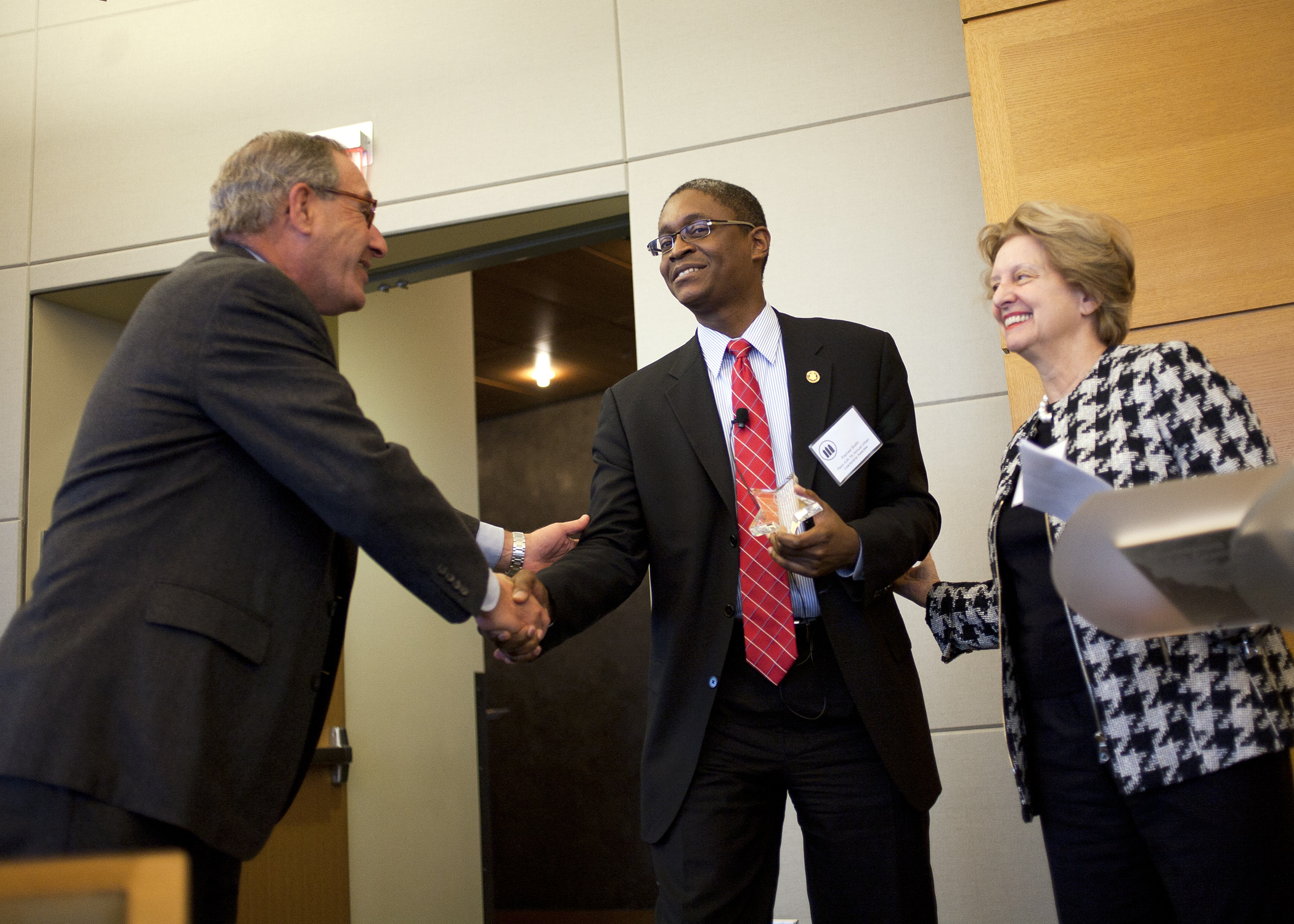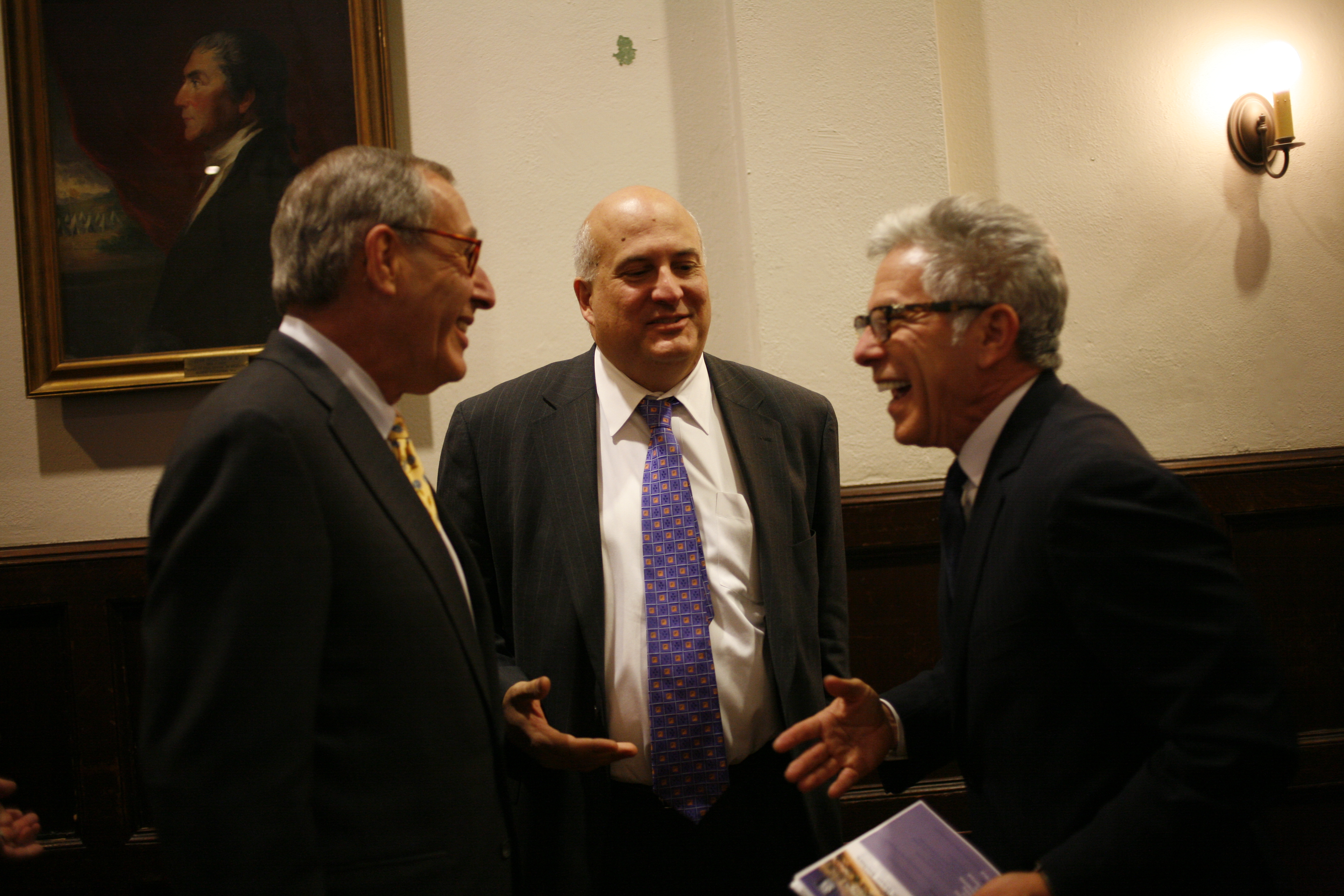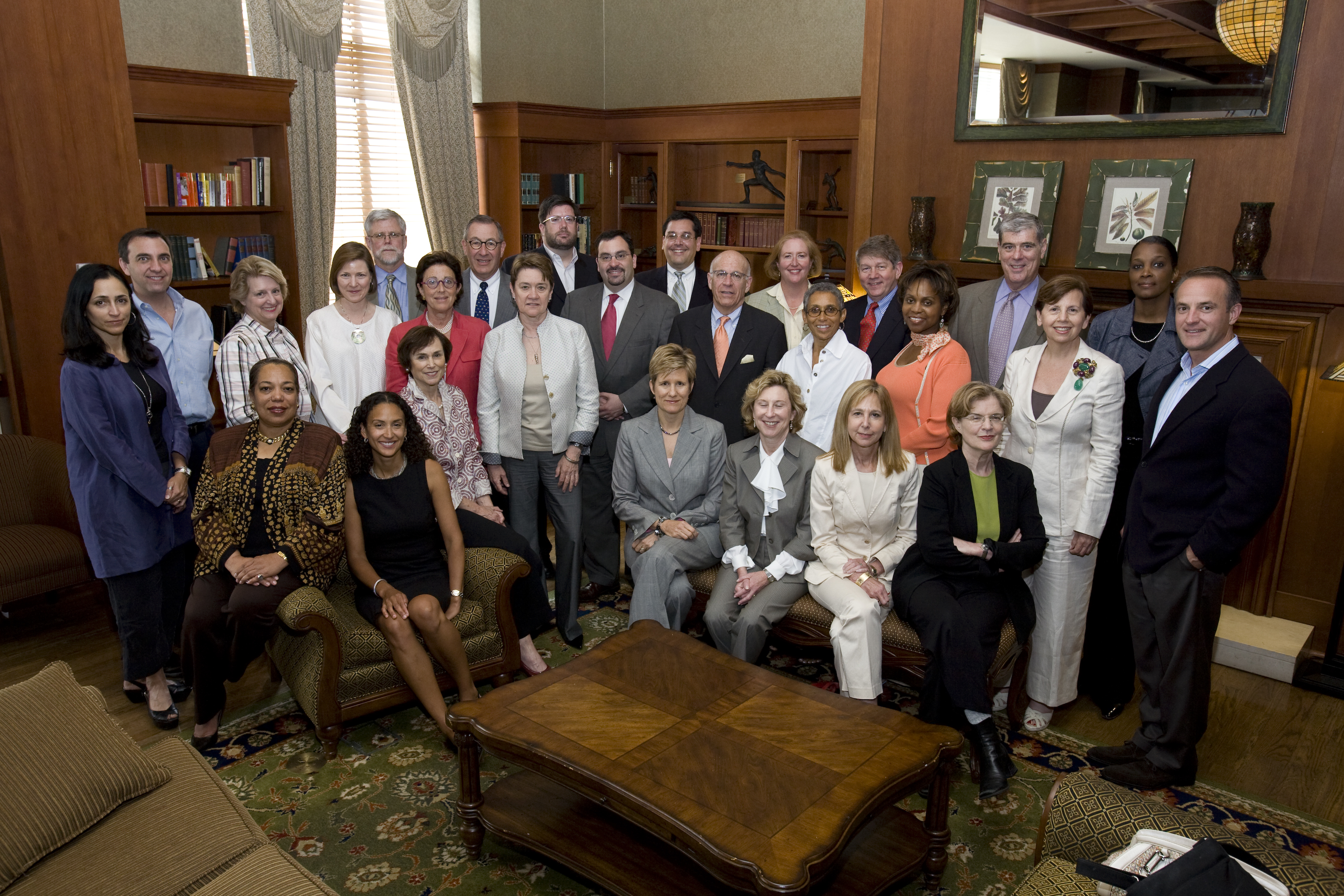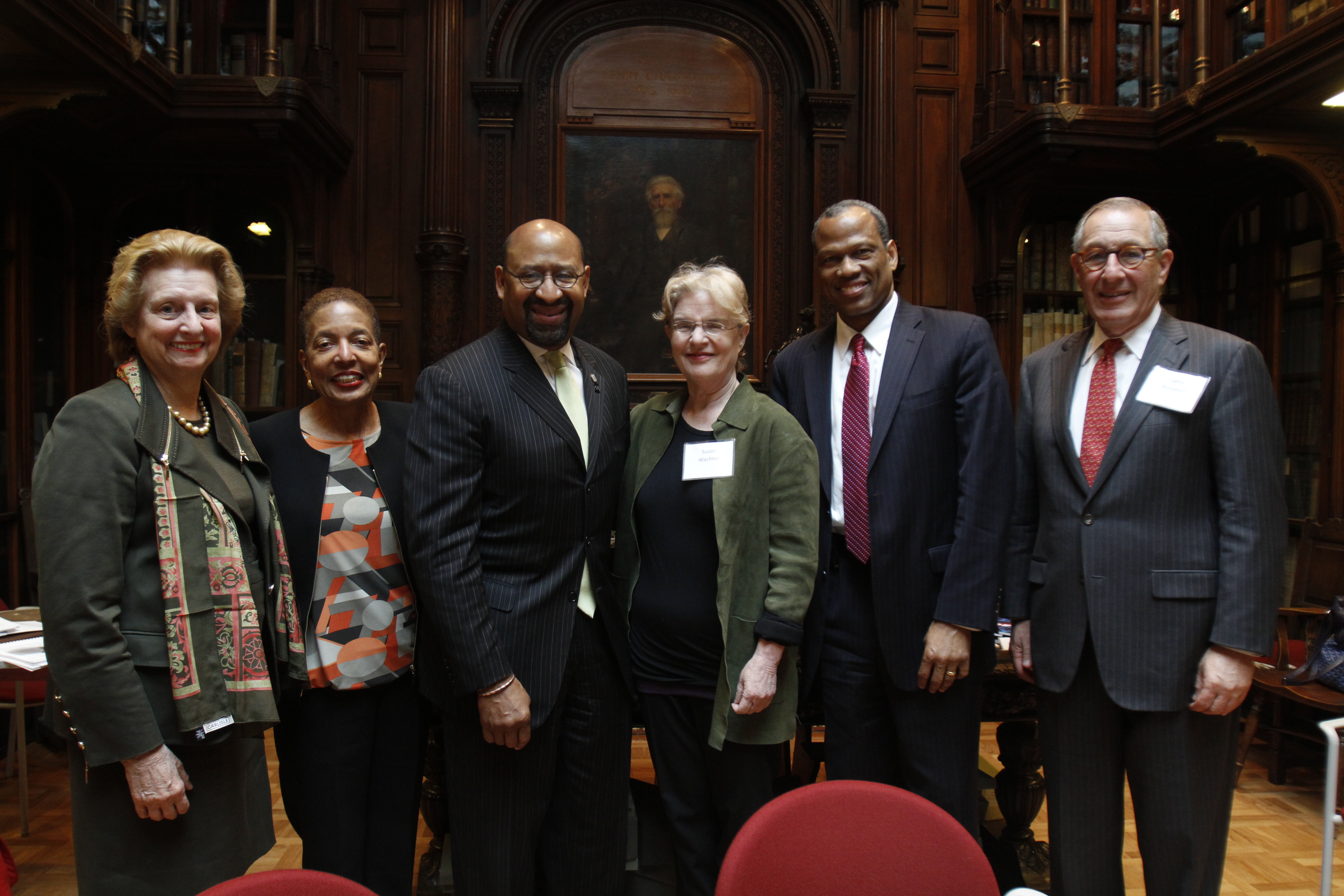It was a beautiful fall evening, October 10th, 2010, as the black-tie crowd assembled in the Annenberg Center for the Performing Arts for the 76th University of Pennsylvania Alumni Award of Merit Ceremony. Larry Nussdorf (1946-2020), W’68 was sitting center stage among the five other honorees. After the opening, the master of ceremonies called Melanie Nussdorf, C’71 and Larry to the podium, noting that with the granting of the award, the Nussdorfs would be one of two couples to be so honored as Melanie was an awardee nine years earlier.
With a warm greeting to the audience, Melanie began: “It is with the greatest honor that I introduce the next Alumni Award recipient … who just happens to be the love of my life ….” They exchanged a special smile and then Melanie got to the heart of the matter. She described what Penn had meant to Larry over the past 40 years: “Penn engages and energizes him; it enlightens and enlivens his view of the world.” She recorded his work with the Graduate School of Education (GSE), on whose Board of Advisors he had served as vice chair, and then observed, ”He was captivated by the innovative ideas of the Penn Institute for Urban Research, never missing a meeting of its Advisory Board and strategizing on the next project, the next forum, the next symposium ….” A bit later, Melanie concluded, listing Larry’s special qualities: “Your good heart along with your integrity, keen intelligence, and ability to cut through problems to arrive at solutions ….”
We, from Penn IUR who were in the audience, nodded knowingly. Melanie had captured Larry perfectly. She missed only one thing: Larry’s unassuming nature. He was, at the time, the president and chief operating officer of Clark Enterprises, the Washington D.C.-based multi-billion-dollar company that had built or invested in a major portion of the capitol’s built environment (arenas, hospitals, metro stations, office and residential buildings) as well as operating throughout the nation.
At the time, Penn IUR, a university-wide center, was six years old, having been founded in 2004 with a simple mandate from then-president Judith Rodin and provost Bob Barchi: unite urban-focused scholarship across Penn and make it more visible worldwide. As we worked with them to craft Penn IUR, the first project was to assemble an external advisory board. They suggested only one name: Larry Nussdorf. Little did we know then what sage advice they gave us. Little did we know then how much Larry would shape Penn IUR, setting it on a firm footing … while gently probing us to examine and evaluate its work continually. Let us try to describe Larry’s gift—in its tangible and intangible forms.
From the beginning, Larry knew that Penn IUR needed to have a strong focus and wide engagement within and outside of the academy. He urged us to articulate clear but inclusive objectives and identifiable themes—informing public and private decision-making on issues of sustainable urban growth and development and understanding the role of anchor institutions in urban places through multi-disciplinary research, instruction, and research. And he held our feet to the fire, reminding us quietly if we were straying or not on point.
A shining example of his advice remains after more than 15 years. It was Fall, 2005. Provost Ron Daniels had invited us, as Penn IUR co-directors, to develop a response to Hurricane Katrina. Thrilled, we sat down and drew up an impossibly elaborate plan including a conference involving every conceivable discipline and broad topics, which we shared with the Advisory Board. As our presentation came to a conclusion, Larry looked up from the multi-page description that we had handed out, frowned slightly and said, “Make it your own—make it urban.” We have never forgotten those seven words, and are guided in all that we do, often repeating a question when faced with some decision: “What would Larry say?”
As it turned out, we went back to the drawing board and created “Rebuilding Urban Places after Disaster, Lessons from Hurricane Katrina,” our first conference and the second book in Penn IUR’s City in the 21st Century series with Penn Press, now with nearly 50 volumes. This effort evolved to include projects such as a collaboration with the East-West Center encompassing a three-year exchange program with Japan on resilience and ongoing projects jointly with the Wharton Risk Management and Decision Processes Center. It is the root of Penn IUR’s current work, Cities and Contagion: Lessons from COVID-19, which includes the Cities and COVID-19 Resource Library, an online compendium of resources for urban practitioners and researchers, and the Recovering Cities Project, which monitors key indicators marking the aftermath of COVID-19 in selected cities in partnership with research institutes nationwide.
Larry’s contributions permeate Penn IUR well beyond that first year’s advice. Generous with his time as chair of the nominating committee, he helped build the Advisory Board, realizing that a strong, talented board would be an essential ingredient for Penn IUR’s success. Notably, in 2007, when Judith Rodin stepped down as Board chair upon assuming the presidency of the Rockefeller Foundation, he recruited Egbert Perry, CE’76, WG’78, and GCE’79, to replace her. Recognizing Perry’s leadership skills, deep interest in Penn IUR’s work, and strategic position on the University’s Board of Trustees, Larry was an astute judge of character. Egbert served as chair for more than a decade, helping clarify Penn’s functions as a lab, voice, and convenor, elements that provide Penn IUR’s signature identity. As Larry wisely observed at the time, “the themes may change but the functions will remain.”
Larry never missed an Advisory Board meeting or an Urban Leadership Symposium. He is pictured here at the 11th symposium with (left to right) Genie Birch, Nussdorf Professor and Penn IUR Co-Director, awardees Renee Glover, Chair of the Board, Habitat for Humanity; Michael Nutter, Mayor, Philadelphia; Penn IUR Advisory Board Chair Egbert Perry; and Penn IUR Co-Director Susan Wachter.
Generous with his ideas, Larry stimulated directly two important streams of Penn IUR research and programming: the Penn IUR Roundtables on Anchor Institutions and Transforming Cities: Municipal Fiscal Stability. In addition, working with Melanie, who was a member of the Board of Advisors of Penn’s School of Nursing, he supported Penn IUR’s work on global women’s health, a multi-year effort that yielded two major conferences, several convenings around the United States, and the highly regarded Women’s Health and the World’s Cities (2013), published in the Penn Press series.
On anchor institutions, Larry’s intellectual and financial support helped Penn IUR develop a major conference (2007) and five day-long roundtables on anchor institutions. The roundtables brought anchor institution leaders to Penn for public meetings to discuss their respective roles and private meetings to engage in peer-level problem solving. The sessions covered Performing Arts Centers (2008), Museums (2010), Ballparks (2011), Eds and Meds (2013), and University-Led Innovation (2015). Larry and Melanie not only attended each one but also were active participants in several. With his experience in building their facilities, Larry introduced us to key leaders for each session. Memorably, he brought us on a site visit to the Nationals Park, recently completed by Clark Construction. There we met with the team’s owner who gave us a tour of the facility and even led us onto the pitching mound, a coveted “inside experience!”

 Larry Nussdorf at the 2014 Urban Leadership Forum with Raphael Bostic, President and CEO of the Federal Reserve Bank of Atlanta and Genie Birch, Nussdorf Professor and Penn IUR Co-Director, (top) and at the 2011 Penn IUR Roundtable on Anchor Institutions with Craig Carnaroli, executive vice president, University of Pennsylvania, and Edward L. Cohen, principal owner, Washington Nationals (bottom).
Larry Nussdorf at the 2014 Urban Leadership Forum with Raphael Bostic, President and CEO of the Federal Reserve Bank of Atlanta and Genie Birch, Nussdorf Professor and Penn IUR Co-Director, (top) and at the 2011 Penn IUR Roundtable on Anchor Institutions with Craig Carnaroli, executive vice president, University of Pennsylvania, and Edward L. Cohen, principal owner, Washington Nationals (bottom).
The anchor work had many outcomes, including Penn IUR and the Netter Center’s policy paper, Retooling HUD for a Catalytic Federal Government (2009) for the Obama administration that took up its key message—put the UD (urban development) back into HUD—and the founding of the Anchor Institutions Task Force in 2009 that now supports a 700-member network. It also stimulated Penn Press publications, including Judith Rodin’s The University and Urban Revival: Out of the Ivory Tower and Into the Streets (2007) and Richard Freedland’s Transforming the Urban University: Northeastern, 1996-2006 (2019), among other publications. In addition, the state of Connecticut selected us to undertake statewide research (ultimately published as (Innovation in Higher Education in Connecticut) to develop the roadmap for the state’s 38 public and private institutions, currently used to guide the state’s Higher Education and Entrepreneurship Fund created in 2017.

The participants in the 2008 Penn IUR Anchor Institution Roundtable on Performing Arts Centers. Larry Nussdorf is the sixth person from the left in the second row.
The work on the transforming cities and municipal fiscal stability initiative has also evolved. It started in September 2004 with Penn IUR’s inaugural public interest series event, Transforming Cities: Positive Outcomes of Public/Private Engagement, a session that established the Penn IUR practice of convening distinguished urban practitioners and thinkers together. At this event, Alice Rivlin, The Brookings Institution; John Timoney, then Chief of Police, Miami (former chief in NYC and Philadelphia); and James Nevels, Chair, Philadelphia School Reform Commission, discussed the impact of contemporary urban policy changes across the country.
The following year, the initiative assessed the role of mayors in urban transformation. This would lead to firsthand accounts by Manny Diaz (Miami Transformed [2012]) and Michael Nutter (Mayor: The Best Job in Politics [2017]). It would also stimulate a strong partnership with Philadelphia’s Federal Reserve Bank that produced three conferences and three books with Penn Press: Neighborhood and Life Chances: How Place Matters in Modern America (2011), Revitalizing American Cities (2013) and Shared Prosperity in America’s Communities (2016). Recently, Penn IUR partnered with the Philadelphia Fed on a virtual series focusing on race and inequality.
By 2007, the transforming cities and fiscal stability initiative added an international dimension. It pursued this area through two conferences at the Rockefeller Foundation’s Bellagio Center, another Penn Press book, Global Urbanization (2011), and a special issue of The Economist. The international work has evolved into a focus on informality and sustainable development including conferences, publications, new courses, and participation in worldwide convenings including Habitat III. It has a full portfolio of activities now being carried out in conjunction with Penn’s Perry World House and Penn Global.
The domestic aspects of the fiscal stability initiative stimulated several public events. They were “Sustainable Public Finance Options” (2011), “Financial Stress in Governments” (2012) with the Fels Institute for Government, and Penn IUR’s 10th anniversary symposium: “Fiscal Stability and Public Pensions” (2014), summarized in Public Pensions and Fiscal Solvency (2016) in the Penn Press series. In 2018, Penn IUR launched the “State & Local Public Finance Links,” a regularly updated web-based resource library. Inspired by the 2014 symposium, a subgroup of the Advisory Board met regularly from 2015 to 2019 to explore pension reform, efforts that led to a partnership with the Volker Alliance whose expertise in state finance complemented Penn IUR’s strength in local issues. In April 2020, this fortuitous arrangement yielded the 18-session virtual series on the effect of COVID-19 on state and municipal finance that has reached thousands of attendees and also yielded an ongoing partnership under the leadership of Bill Glasgall and Dick Ravitch.
Many more instances of Larry’s support exist because at every moment he was ready to help with a speaker, an idea for a lecture or a new member of the Advisory Board. His office door was always open when we, along with Paula Clark, Executive Director, Principal Gifts at the University of Pennsylvania, would pay a visit to Washington. As can be seen in the brief account above, Larry’s impact is deep-rooted and enduring—it touched every aspect of Penn IUR.
Larry’s acceptance speech for the 2010 Alumni award offers an explanation for his immense assistance and encouragement: “For me, Penn has been a family affair. As many of you know, not only is Melanie an active alum, as are my two sons, Jed and Ben, and daughter-in-law, Ina. But my family extends well beyond those who are related to me by blood and marriage …” and he listed those Penn family members. So, he treated us as family, taking care, paying attention, and supporting us in all things. We are eternally grateful.
We at Penn IUR are not the only ones to appreciate Larry’s massive contributions to their professions, philanthropic work, and home city as reflected in recent tributes: Clark Enterprises (“Larry made an indelible mark on who we are today”), the Clark Foundation (“He was an incisive advisor”), the Washington Biz Journal (“A titan of Greater Washington’s commercial real estate industry”) and The Washington Post that outlined his many professional accomplishments. Perhaps one of his greatest tributes occurred years ago, in 2004, when James A. Clark affirmed his high esteem for Larry’s ethics and ability by honoring him with the gift to Penn of the Lawrence C. Nussdorf Chair in Urban Research and Education. And Larry, in a further mark of his generosity, dedicated the chair to the Penn Institute for Urban Research.
So we are not saying good bye to Larry—it’s impossible, he is in every part of Penn IUR and will be there forever.



